Rose Anderson's Blog, page 17
February 22, 2015
Fun Day Sunday & Weekend Happenings
 If you’ve been here before then you know Sundays on my blog are all about wonder and smiles. In honor of mentally kicking back once in a while, Sundays are Fun Days! Each Sunday, visitors will find a fun, interesting, or unusual something here. I’m a nerd with a complex sense of humor and absurd wit. It could literally be anything.
If you’ve been here before then you know Sundays on my blog are all about wonder and smiles. In honor of mentally kicking back once in a while, Sundays are Fun Days! Each Sunday, visitors will find a fun, interesting, or unusual something here. I’m a nerd with a complex sense of humor and absurd wit. It could literally be anything.
I’ve always shared my life with pets, furred, feathered, scaled, and more. I still do. Animals just enrich our lives. I stumbled upon these fanciful little food fests last year. This looks like something my kids would have done when they were young. Very cute.
Take in the looks of yummy bliss on these little faces. I hope you enjoy their smiles and gain one of your own.
Adorable. See the rest of the mini food fests~
http://youtu.be/iieQDN7l_Yw
http://youtu.be/XPHlHuhBVFI
http://youtu.be/LqbYVr5jBVk
http://youtu.be/JOCtdw9FG-s
❋❋❋
My Other Weekend Happenings~
Weekend Writing Warriors
http://theancillarymuse.blogspot.com/
My Sexy Saturday & Sexy Snippets
http://calliopesotherwritingtablet.blogspot.com/
Sunday Snippet
**A promo op for you too!**
http://exquisitequills.blogspot.com/
~❋~❋~❋~
 Today is Author Desiree Holt’s blog day.
Today is Author Desiree Holt’s blog day.
http://romancebooks4us.blogspot.com/
Romance Books ‘4’ Us ~ Our February contest is on.
Two – $50 GIFT CARDS & MORE.
~❋~❋~❋~❋~❋~❋~❋~❋~❋~❋~❋~
If you enjoy my daily musings, subscribe to get them sent to your inbox, or if your inbox is as packed as mine is, check out the Networked Blogs tab on the right and get all the blogs you follow in one daily notice. A year full of curious and compelling posts awaits!
 Sample my scorching love stories for free!
Sample my scorching love stories for free!
~Coming Soon~


February 21, 2015
From the Stacks 5
My recent foray into the document folder turned up bits of writing from one of my favorite blog events from Aprils past –the A to Z Challenge. They’re pretty interesting, if I do say so myself. I’ve been sharing a few until life quiets down around here. I hope you enjoy.
:D
E for Easter Island Moai
 The ancestors of the Polynesians reached the far corner of the triangular Pacific island territory that made up their world at about 1000 BCE. These peoples were nighttime seafarers and followed the heavens until they chanced upon a remote land mass and made it their home. We know that land as Easter Island.
The ancestors of the Polynesians reached the far corner of the triangular Pacific island territory that made up their world at about 1000 BCE. These peoples were nighttime seafarers and followed the heavens until they chanced upon a remote land mass and made it their home. We know that land as Easter Island.
It’s said the island once had a thriving population, as many as 15,000 inhabitants. Just 100 years before the Dutch arrived in 1722, the history of the island says two factions –the Short-Ears and the Long-Ears– had a civil war. In 1770 a Spanish expedition found a population of 3000. Just four years later when British navigator Sir James Cook entered the scene, only around 600 men and fewer than 30 women remained. By 1877 only 111 native peoples were left. Were I to guess, I’d say diseases like smallpox contributed to the population’s decline. Any western disease to an isolated population would exact a terrible toll.
Before the Dutch decided to name the island for Easter Sunday, the day of their discovery, oral tradition says one of the island’s names was Eyes looking to the sky. Others use the name Rapa Nui. I think Eyes looking to the sky fits beautifully because of more than 1000 Moai — the famous Easter Island heads.
Surprising fact #1: The familiar heads are actually full-bodied statues buried to their chins in sediment. Recent archeological digs reveal the Moai have arms and wear sculpted clothing. They have tattoos too.
Who knew?
With their heavy brows and chiseled profiles (no pun intended), these enigmatic statues epitomize the mystery of the place. All but seven watch over the land, their backs to the sea. The seven facing the vast blue ocean are thought to wait for their king. No one really knows why they’re there or what was meant in their creation. There’s an assumption that the Moai were made in the likenesses of ancestors. There is also some thought that the bodies housed the essence of the sacred. One of the more interesting bits of information I’ve uncovered has to do with Leprosy. There’s some opinion that the Moai’s severe physical features may indicate the ravages of that terrible disease — that perhaps the Moai were made to ritually undo the effects in the spirit world. (Apparently the afflicted were ostracized on other Polynesian islands.) As I haven’t uncovered more than that regarding leprosy, I’ll take that supposition with a grain of salt.
Another mystery is the complete lack of trees. Islands by nature are fragile ecosystems. By the time of European discovery, this one was deforested. To peoples relying upon the sea for most of their food, lack of wood would mean starvation in the long run. Perhaps this added to their population decline. If you can’t build boats, you can’t fish beyond the shoreline. Were the island’s forests cut down to make transport logs for the 13 ton Moai? That was the prevailing thought for years. But then someone made an brilliant deduction…
Surprising fact #2
Legend says the Moai walked from the places they were carved. That’s right, the 13 foot tall, 13 ton statues carved from volcanic tuff walked to their resting places. The largest statue made of a single block weighs about 82 tons and is approximately 32 feet tall. To see that walking down from the hills must have been a powerful sight.
I can’t explain it better than this. And seeing is believing!
http://www.youtube.com/watch?v=J5YR0uqPAI8
More:
Easter Island was made an UNESCO World Heritage Site in 1995.
See the full uncovered Moai
Save the Easter Island Statues
An interesting explanation of the island’s Bird Man Cult
~*~
E for Enterolith.
When Ron Weasley inadvertently drank poison in the novel The Half-Blood Prince, Harry Potter saved his life by stuffing a bezoar into Ron’s mouth. A bezoar is an Enterolith — a stone-like formation, or concretion, found in the gastrointestinal tract of certain animals, especially ruminants (cattle, sheep, goats, deer, and giraffes). Just like a pearl forming around a grain of sand inside a mussel shell, enteroliths generally grow around an undigestible irritant such as a stone or piece of twine. They’re mostly comprised of hair and stomach secretions and are really not all that rare. Odd to note, these stones have inexplicably built a reputation as lucky things. Odder still, enteroliths are ground and used as Chinese folk medicine.
The name bezoar comes from the Arabic word badzehr, which literally means antidote. For centuries, enteroliths were believed to cure the effects of any poison, hence JK Rowling’s use of them in the Harry Potter story. This age-old belief was put to a test in 1575, when a cook at King Henry III”s court was caught stealing and was sentenced to death by hanging. It just so happened that Ambroise Pare, surgeon and bezoar skeptic, desired to test the antidote properties of the enterolith that day. Given the choice, the cook agreed to be poisoned rather than be hung. Needless to say, the cook died in agony several hours later. Bezoars are also said to cure animals and people of rabies. This is done by attaching the stone to the wound to suck out the poison.
Considering their historical and modern uses, it’s no surprise that enteroliths are also called Madstones. This makes perfect sense to me.
 Imagine popping one of these beauties into your mouth. *gag*
Imagine popping one of these beauties into your mouth. *gag*
Come back tomorrow for my Funday Sunday post!
~❋~❋~❋~
 Today is Author Renee Vincent’s blog day. http://romancebooks4us.blogspot.com/
Today is Author Renee Vincent’s blog day. http://romancebooks4us.blogspot.com/
Romance Books ‘4’ Us ~ Our February contest is on. Two – $50 GIFT CARDS & MORE. Authors~ check out our promo services.
~❋~❋~❋~❋~❋~❋~❋~❋~❋~❋~❋~
If you enjoy my daily musings, subscribe to get them sent to your inbox, or if your inbox is as packed as mine is, check out the Networked Blogs tab on the right and get all the blogs you follow in one daily notice. A year full of curious and compelling posts awaits!
 Sample my scorching love stories for free!
Sample my scorching love stories for free!
~Coming Soon~


February 18, 2015
From the Stacks 4 & Hump Day Happenings
Boy is it cold outside. I heard it was in the 20s down in New Orleans for Mardi Gras. Too cold for that far south. I checked our weather for today and see we have a wind chill advisory on. The little dog and I will forgo our midday walk. Neither of us need frostbite. She’s such a high-energy little pup. She needs that brisk walk as much as I do. If only I could get us both on the treadmill together.
:)
I felt the vibration of seasonal discontent the other day — little things like walls needing spackle and paint touch-ups and windowless bathrooms in need of a good bleaching. That vibration means I’ll be spring cleaning soon. I mentioned it to my husband the other morning. His reply — Great. Mind you, “great” must be imagined with the Volga Boatmen song playing in the background. The poor man. I’ve been doing my spring cleaning/annual purge for nearly 30 years. lol
I’ve already started cleaning out my computer. Good lord I save everything..something things more than once! I’ve found bits of writing from my two favorite events from Aprils past– the Authors in Bloom blog hop and the A to Z Challenge. They’re pretty interesting, if I do say so myself. I’ve been sharing a few A to Z posts lately.
Today it’s D. I hope you enjoy.
:D
D for Doggerland
Sometime in the middle of the last century, trawling Dutch fishermen working the North Sea began hauling up things in their nets no one ever expected to see — enormous tusks and bones from wooly mammoths and mastodons, and the bones of giant aurochs, woolly rhinos, and other ice age animals. The story goes that fishermen threw these things back in the water, being set in their opinions of what one should expect to haul from the sea.
Amateur paleontologist, Dick Mol, heard of the unusual findings and persuaded the fishermen to bring their tusks and bones to him along with the coordinates of where they had been found. Imagine his surprise when the captain bought him a well-preserved human jawbone with worn molars. Radiocarbon dating says the jawbone is 9,500 years old and came from a man living in the Mesolithic period (12,000 years ago)
Why would a 9,500 year old jawbone be trawled from the North Sea?
During the last ice age, Great Britain wasn’t a handful of islands, it was the western-most tip of the glaciated European mainland. As much of the earth’s water was tied up in ice, lowlands weren’t submerged as they are today. This low-lying land that tied the UK to the rest of Europe was approximately 18,000 square miles in size. This region is refereed to as Doggerland (named for the Dogger Bank — a large hazardous sandbank). The area is thought to have supported large numbers of Mesolithic people. Among fossilized evidence of mammoths and other mega-fauna and game animals, divers have also found harpoons, flint tools, and suspected burial sites. It would appear people lived on Doggerland until the rising sea swallowed a substantial portion of the landmass and cut the UK from the continent. Exploration is ongoing and researchers expect to find standing stones and burials in addition to settlement areas. Can you just imagine? :D
This fascinating video is shown in 7 parts.
Follow the links at the end of each clip to the next chapter
D for Dolmen.
Usually, when people think of megalithic construction, the first thing that comes to mind is Stonehenge. The fact is, there are prehistoric stoneworks of all sorts peppered across Europe, the Middle East, parts of Asia, and even in the Americas. The early Neolithic period (4000 to 3000 BCE) saw a lot of this puzzling megalithic construction. One such enigma is the dolmen.
A dolmen, also known as a portal tomb or quoit, consists of large upright stones that support an equally large and flat horizontal capstone. It’s believed they were originally covered with earth and what we see today is actually the skeleton of the structure.
No one knows exactly who built them or what their purpose was. The most widely accepted theory is dolmen are tombs or burial chambers, but there’s little archeological evidence to back that up. The one thing everyone is certain of… they’re old. At least 7000 years old. This means the mysterious builders were contemporaries of the ancient Egyptians.
 Other Wednesday Happenings
Other Wednesday Happenings
Books Hooks
http://theancillarymuse.blogspot.com/
Paranormal Love Wednesday *NEW for me*
http://calliopesotherwritingtablet.blogspot.com/
Hump Day Blurb Share
(Open promo opportunity for authors. Readers find great reads!)
http://exquisitequills.blogspot.com/
~❋~❋~❋~
 Today’s guest is Author Nina Pierce
Today’s guest is Author Nina Pierce
http://romancebooks4us.blogspot.com/
Romance Books ‘4’ Us ~ Our February contest is on.
Two – $50 GIFT CARDS & MORE.
Authors~ check out our promo services.
~❋~❋~❋~❋~❋~❋~❋~❋~❋~❋~❋~
If you enjoy my daily musings, subscribe to get them sent to your inbox, or if your inbox is as packed as mine is, check out the Networked Blogs tab on the right and get all the blogs you follow in one daily notice. A year full of curious and compelling posts awaits!
 Sample my scorching love stories for free!
Sample my scorching love stories for free!
~Coming Soon~


February 17, 2015
From the Stacks 3
My son is on the mend and has returned to his own house to finish recuperating from surgery last week. My thanks to everyone who emailed and posted good wishes. You’re the best.
I’m getting back into the swing of things myself. Though my parental fretting shut down fresh creativity for a while, cleaning my document files last weekend got me seeing possibilities again. Yesterday I found myself working on my magnum opus. If it’s your first time here, that’s my enormous 500k-word as-yet-unnamed labor of love I was working on when I decided to take a brief detour as a romance writer. Who knows where that small creative flame may take me today.
:)
So back to that bloated document file of mine…
I mentioned the other day that I’m an info hoarder and my laptop’s document folder is like the ubiquitous junk drawer. You know, that catch-all in the kitchen that holds too many rubber bands, wine corks, and other odds and ends that mysteriously multiply over the course of the year? Some of the things I’ve found are bits of writing from my two favorite events from Aprils past– the Authors in Bloom blog hop and the A to Z Challenge. Until my usual urge to blog over my morning coffee returns, I’ll be sharing some more past A to Z posts. They’re pretty good if I do say so myself.
:D
As I’ve already offered A and B, today it’s C. I hope you enjoy.
C for Cryptozoology.
Fifty-four years ago, Lucien Blancou coined the term Cryptozoology out of a combination of three Greek words: kryptos, zoon and logos, which mean, respectively, Hidden, Animal, and Discourse. By definition, it is the study of unknown animals.
Global exploration expanded when man mastered the sea. New uncharted lands held strange plants and animals never before seen. These native legends, rare sightings, and tales of inexplicable bodies seemingly made of parts, weren’t believed to exist. On this skeptic’s list from the past are creatures we all know today. Here are just a few: giraffe, kangaroo, tapir, beaver, okapi, panda, duck-billed platypus, Komodo dragon, orangutan, and the living fossil fish, the coelacanth.
Then you have creatures on the truly odd list. The most famous is the Loch Ness Monster. Actually many large bodies of water around the world have purported Nessie-ish creatures — Lake Champlain has Champy, and the Congo River has Mokèlé-mbèmbé for example. Then we have the chupacabra, the Sasquatch, and the recently verified Giant Squid (the possible Kraken of mythology.) More often than not, Cryptozoology is dismissed as pseudo-science by conventional fields of study. I think it’s that whole Big Foot thing. :)
Several years ago I came upon a local legend and recently wrote a what if story around it.
Read More: USA Today — The Witchy Wolf and the Wendigo
C for Cholera in London 1854
Waste and habitation have always gone hand in hand. Humanity’s sloppy habits reveal themselves in our midden piles, cesspits, latrines and the like. Somewhere along mankind’s history someone decided this waste could be washed away by water and so the short-sighted habit of polluting waterways with human excrement began. Woe be to anyone downstream. Unfortunately this out of sight out of mind mentality came with dire consequences — the spread of disease.
In Victorian London of 1854, the prevalent view on disease origins wasn’t on germ theory – that idea that microbes were causes of disease. That would come later in the century with Pasteur and others blaming germs for all manner of ills. Doctors and scientists in the mid-1800s were still going by the erroneous opinions of the Roman empire’s own Greek physician, Galen, who believed disease was caused by air-borne miasma.
Example: It wasn’t the bacteria in the water you drank that gave you a deadly case of diarrhea. The fetid smell of the nearby cesspit was to blame. It sounds rather ridiculous now, but if you think about it there was a sort of truth to that suspicion. We often use our noses to determine if something is spoiled and if presented with a choice, we certainly wouldn’t eat or drink something that smelled bad. I think this long-standing miasma belief was instinctual — a subconscious intuition that bad things could come from foul pools of stagnant water and we should steer clear. Today we know without a doubt that mosquitoes are vectors that transmit many diseases. Mosquitoes breeding in stagnant pools give us Malaria, Yellow Fever, West Nile, Dengue, Filariasis, and several varieties of Encephalitis.
So back to London…
High population and lack of proper sanitary services saw London’s Soho district’s cesspits overflowing that hot August of 1854. It was so bad in fact, the summer was referred to as The Great Stink because of it. As everyone believed bad smells caused disease, what else to do but flush those cesspits right into the River Thames.
 Just prior to the flushing, the residents in one area were hit with a small outbreak of profuse diarrhea and vomiting of clear fluid (literally gallons a day until they either recovered or died). After the raw sewage waste of the infected was washed into the river, it contaminated the public water pump and an epidemic began. In a span of a week a full 10% of the very crowded neighborhood perished.
Just prior to the flushing, the residents in one area were hit with a small outbreak of profuse diarrhea and vomiting of clear fluid (literally gallons a day until they either recovered or died). After the raw sewage waste of the infected was washed into the river, it contaminated the public water pump and an epidemic began. In a span of a week a full 10% of the very crowded neighborhood perished.
Local physician, Dr. John Snow was a longtime skeptic to the miasma theory. For years he tried, unsuccessfully, to convince his peers cholera was a water-borne disease. Seeing opportunity for answers with this localized outbreak, he teamed up with Reverend Henry Whitehead (a man who knew just about every man, woman, and child in his parish) and began asking questions. They soon discovered the afflicted drew water from one specific pump. Dr. Snow confirmed the contamination by viewing a water sample through his microscope and finding the boomerang-shaped bacterium — the same bacterium present in the bodily fluids of the sick and dying. On a hunch, he lobbied for the pump handle to be removed.
In John Snow’s letter to the editor of the Medical Times and Gazette, he said this:
On proceeding to the spot, I found that nearly all the deaths had taken place within a short distance of the Broad Street pump. There were only ten deaths in houses situated decidedly nearer to another street-pump. In five of these cases the families of the deceased persons informed me that they always sent to the pump in Broad Street, as they preferred the water to that of the pumps which were nearer. In three other cases, the deceased were children who went to school near the pump in Broad Street.
With regard to the deaths occurring in the locality belonging to the pump, there were 61 instances in which I was informed that the deceased persons used to drink the pump water from Broad Street, either constantly or occasionally. The result of the inquiry, then, is, that there has been no particular outbreak or prevalence of cholera in this part of London except among the persons who were in the habit of drinking the water of the above-mentioned pump well. I had an interview with the Board of Guardians of St James’s parish, on the evening of the 7th, and represented the above circumstances to them. In consequence of what I said, the handle of the pump was removed on the following day.
Here’s a TED Talk from an author who wrote a
fascinating book on the subject. I recommend.
http://www.youtube.com/watch?v=KvHL0dHj3RM
More:
With the Help of Victims From 1849,
Scientists Decode Early Strain of Cholera
You may ask yourself why anyone would reproduce deadly diseases in the laboratory.
The simplest answer is when you understand how a pathogen works,
you better your chances of fighting it.
Cholera in America’s Old South
~❋~❋~❋~
 Today is Author Jean Hart Stewart’s blog day.
Today is Author Jean Hart Stewart’s blog day.
http://romancebooks4us.blogspot.com/
Romance Books ‘4’ Us ~ Our February contest is on.
Two – $50 GIFT CARDS & MORE.
Authors~ check out our promo services.
~❋~❋~❋~❋~❋~❋~❋~❋~❋~❋~❋~
If you enjoy my daily musings, subscribe to get them sent to your inbox, or if your inbox is as packed as mine is, check out the Networked Blogs tab on the right and get all the blogs you follow in one daily notice. A year full of curious and compelling posts awaits!
 Sample my scorching love stories for free!
Sample my scorching love stories for free!
~Coming Soon~


February 16, 2015
From the stacks 2
Oh the stuff I hang on to. I mentioned the other day that my laptop’s document folder is like the ubiquitous junk drawer. You know, that catch-all in the kitchen that holds too many rubber bands, wine corks, and other odds and ends that mysteriously multiply over the course of the year? Some things I’ve found are bits of writing from my two favorite events of Aprils past– the Authors in Bloom blog hop and the A to Z Challenge. I’ll be sharing some more past posts this week. As I offered A the other day, today I’ll go with B. I hope you enjoy.
B for Bioluminescence.
Who hasn’t captured a firefly on a warm summer evening? I remember those bug-smelly jars with holes punched in the lids and a handful of grass on the bottom. In my Chicago neighborhood, mobs of children scrambled over lawns at dusk with one thought in mind – to catch the most.
Those summertime flashes are known as bioluminescence – a natural ability of some living organism to emit cold light. In our human experience, light almost always gives off heat: sunlight, firelight, gaslight, electric light, nuclear reaction light. In the animal kingdom, this heat-free process is seen in sea creatures, certain insects and their larvae, worms, and spiders. We also see it in mushrooms and bacteria. From the first time my grubby little hands held a stinky firefly I’ve wondered how it lit up its tail end. Now I know.
:)
The cold light is produced by chemical reaction. One chemical, luciferin** is a substrate – That is, a substance which is acted upon by an enzyme. The other chemical is the enzyme itself – luciferase. Different creatures produce a range of these chemicals, resulting in different colors of light.
Fungi glow bluish-green night and day. This too is a chemical reaction, but the verdict is out on just what the purpose is. Some scientists feel it deters creatures that would eat the fungi, while others feel it’s a way to draw attention and get better spore distribution. And others believe, in some species, this glow attracts beneficial insects that eat damage-causing insects. Bioluminescent bacteria are believed to use their glow to communicate with one another. While fireflies are somewhat yellow, marine life most often produces the color blue. This makes sense because the color blue falls in the high-frequency end of the visible light spectrum, meaning blue light would penetrate the farthest through water.
However it’s used, bioluminescence in the animal world has purpose. In the ocean, bioluminescence can lure food, attract a mate, and warn off or make your shape visually confusing to predators. There’s a species of shrimp that sends out a cloud of blindingly bright goo in a last ditch effort to get away from whatever is trying to eat them. On the other side of the predator/prey relationship, the angler fish dangles his little lantern like a lure to draw his prey closer to his mouth.
Insects have both uses for their glow too. The nighttime flash of the firefly is meant to attract a mate. This summer, pay attention to how many times the fireflies flash. If a firefly flashes his light twice, it will attract a two-flash species. If a firefly flashes three times, that’s meant to attract a three-flash species. But there’s an interesting tidbit of firefly bioluminescence that’s worth adding here, there are predator fireflies out there who mimic the flashes of other species. They use their bioluminescence to trick, capture, and eat those unsuspecting fireflies who are just trying to get on with the mating business. It adds a whole layer of drama to a warm summer night, doesn’t it? What a wondrous world we live in.
**Luciferin was named for the fallen archangel Lucifer. The name means bringer of light.
More~
http://www.youtube.com/watch?v=IThAD5yKrgE?rel=0
B for Baghdad Battery
One of the more unusual artifacts discovered on an archaeological dig turned up approximately 20 miles outside of Baghdad, Iraq in 1936. At first glance the finds appeared to be simple clay jars with iron lids and asphalt seals. They stood several inches tall and each had a copper tube with an inserted iron rod down the center. No one gave them much attention at the time.
Three years later, German archaeologist Wilhelm Konig was rooting around the stored antiquities in the National Museum of Iraq. Upon finding these odd vessels he drew a rather startling conclusion. The jars looked like galvanic cells — in other words — batteries. Residue showed the jars had held slightly acidic liquid.. perhaps wine, vinegar, or citrus juice. The different metals involved would react to the acid and produce a mild electric current. Reconstruction of this odd device proves it generates a current between 0.4 and 1.9 volts.
There is some speculation among people who study such things that the Baghdad batteries could have been use medicinally for pain relief in the same manner electrical current is used today. Another opinion suggests they were used for electroplating. Whatever these inventions were used for, their modern counterpart didn’t come about until 2000 years later.
More~
This explains a likely use for the Baghdad battery.
This offers a peek into the battery assembly should you care to make one
yourself. How cool is that?
youtube http://www.youtube.com/watch?v=dR2EsV4yGf8
~❋~❋~❋~
 Today our guest is Jim Azevedo, marketing director at Smashwords.
Today our guest is Jim Azevedo, marketing director at Smashwords.
http://romancebooks4us.blogspot.com/
Romance Books ‘4’ Us ~ Our February contest is on.
Two – $50 GIFT CARDS & MORE.
~❋~❋~❋~❋~❋~❋~❋~❋~❋~❋~❋~
If you enjoy my daily musings, subscribe to get them sent to your inbox, or if your inbox is as packed as mine is, check out the Networked Blogs tab on the right and get all the blogs you follow in one daily notice. A year full of curious and compelling posts awaits!
 Sample my scorching love stories for free!
Sample my scorching love stories for free!
~Coming Soon~


February 15, 2015
Fun Day Sunday & Weekend Happenings
 If you’ve been here before then you know Sundays on my blog are all about wonder and smiles. In honor of mentally kicking back once in a while, Sundays are Fun Days! Each Sunday, visitors will find a fun, interesting, or unusual something here. I’m a nerd with a complex sense of humor and absurd wit. It could literally be anything.
If you’ve been here before then you know Sundays on my blog are all about wonder and smiles. In honor of mentally kicking back once in a while, Sundays are Fun Days! Each Sunday, visitors will find a fun, interesting, or unusual something here. I’m a nerd with a complex sense of humor and absurd wit. It could literally be anything.
This one will blow your mind. It’s about Cymatics — the study of visible sound vibration. I’ll be blogging this in depth for the A to Z Challenge in April.
❋❋❋
~My Other Weekend Happenings~
Weekend Writing Warriors
http://theancillarymuse.blogspot.com/
My Sexy Saturday & Sexy Snippets
http://calliopesotherwritingtablet.blogspot.com/
Sunday Snippet
**A promo op for you too!**
http://exquisitequills.blogspot.com/
~❋~❋~❋~
 Today is Author Fran Lee’s blog day.
Today is Author Fran Lee’s blog day.
http://romancebooks4us.blogspot.com/
Romance Books ‘4’ Us ~ Our February contest is on.
Two – $50 GIFT CARDS & MORE.
~❋~❋~❋~❋~❋~❋~❋~❋~❋~❋~❋~
If you enjoy my daily musings, subscribe to get them sent to your inbox, or if your inbox is as packed as mine is, check out the Networked Blogs tab on the right and get all the blogs you follow in one daily notice. A year full of curious and compelling posts awaits!
 Sample my scorching love stories for free!
Sample my scorching love stories for free!
~Coming Soon~


February 13, 2015
From the stacks
Thanks, everyone, for all the well wishes and inquiries on my son’s health. His surgery went well. He’s home for a few days to recuperate, then back to his own house he goes. As for me…I can almost hear the gray hair growing amongst the red.
I mentioned the day before yesterday that I have that case of writer’s block again. Too much on my mind, I guess. I spent all afternoon sorting files yesterday. Good grief I’m a file slob — poorly named files, duplicates, unnamed projects and Publisher files, copies of the same image files. The list goes on. Oh the stuff I hang on to. My document folder is like the junk drawer catch-all in the kitchen — too many rubber bands and wine corks. Ugh. It’s like I have an information-based hording disorder! lol
Some of the things I’ve been holding on to are bits of writing for my two favorite events in April — the Authors in Bloom blog hop and the A to Z Challenge. I like these two because they have next to nothing to do with my romance novels. Don’t get me wrong, I’m very fond of my novels as they are extensions of my psyche. I know I’ve shared before that I just don’t see myself as a romance novelist. Never did. I’m a romance reader. I only took this route because it was a fast way into the publishing business and I had things to learn for my larger writing project–my 5-book, 500k, as yet unnamed magnum opus (or MO for short). I’ve learned a lot. Now I need to finish all those romance novels in various stages of completion and move on! So many in queue…
While slogging through the pigsty that I call my document folder, I found my previous posts for Letter A in the A to Z Challenge. I thought I’d share them. The universe knows no fresh writing will get done until my son is back on his feet. There’s nothing so all-consuming as parental fretting. Would that I could take his pain on myself so he didn’t have to.
Here’s A from past A to Z Challenges. I find both topics fascinating.
A for Antheketera Mechanism
When a group of Greek sponge divers found an ancient wreck off the Greek island of Antikythera in 1900, they came upon a lump of corroded bronze that astonished experts in the field of ancient studies. Under that corrosion lay an analog computer more than 2000 years old. Named for the island, the Antikythera Mechanism is the most sophisticated machine known from the ancient world.
Modern micro-focus three-dimensional x-ray imagery revealed a complex machine of small precise gears and fine inscriptions written on the parts. We now know the device was made to track astronomical phenomena, specifically the cycles of the Solar System.
:) Fascinating stuff! Here’s a very nice rundown on Youtube. There are a lot more to be found on Youtube if you’d like to learn more about this cool ancient gadget.
More~
See the facsimile http://www.youtube.com/watch?v=UpLcnAIpVRA?rel=0
A for Automaton
Mention cuckoo clock and the first image coming to my mind is a wall clock — one with a small door through which a little bird pops out on the hour and says cuckoo. Clockwork mechanisms like this are called automatons. Automaton means to act under one’s own will. Like music boxes, these fanciful and intricate machines are built with wheels and cogs and generally wind up with a key or with weights. Once wound, they will continue to move their gear and cog parts which animates their articulated components, until their inner springs fully unwind.
The ancient world knew such mechanical devices. Automatons have a long history and even older mythology. In Judaism the Golem was an automaton made of stone and mud. In Ancient Greece, smithy to the gods Hephaestus built Talos — a mechanical man of bronze who patrolled the island of Crete. And who hasn’t heard of the wooden boy Pinocchio and The Wizard of Oz’ tin man?
Throughout history, inventors have used imagination and clockmaker’s precision to devise all manner of animated creations. In my research I’ve come across many different kinds and from simple to complex. Some are adorable and others are nightmares in the making.
I came across this interesting reference taken from Joseph Needham’s Science and Civilization in China. Sometime during the Zhou Dynasty (around 1000BCE), Yan Shi, a mechanical engineer or artificer presented King Mu with a life-size human automaton.
“The king stared at the figure in astonishment. It walked with rapid strides, moving its head up and down, so that anyone would have taken it for a live human being. The artificer touched its chin, and it began singing, perfectly in tune. He touched its hand, and it began posturing, keeping perfect time… As the performance was drawing to an end, the robot winked its eye and made advances to the ladies in attendance, whereupon the king became incensed and would have had Yan Shi executed on the spot had not the latter, in mortal fear, instantly taken the robot to pieces to let him see what it really was. And, indeed, it turned out to be only a construction of leather, wood, adhesive and lacquer, variously coloured white, black, red and blue. Examining it closely, the king found all the internal organs complete—liver, gall, heart, lungs, spleen, kidneys, stomach and intestines; and over these again, muscles, bones and limbs with their joints, skin, teeth and hair, all of them artificial… The king tried the effect of taking away the heart, and found that the mouth could no longer speak; he took away the liver and the eyes could no longer see; he took away the kidneys and the legs lost their power of locomotion. The king was delighted.”
I can see this unfolding in my mind’s eye. That tale makes my imagination soar. :)
More~
http://www.youtube.com/watch?v=SzOgsaXO7BE
Fun and more than a little creepy, no?
~❋~❋~❋~
 Today is Author Cindy Spencer Pape’s blog day.
Today is Author Cindy Spencer Pape’s blog day.
http://romancebooks4us.blogspot.com/
Romance Books ‘4’ Us ~ Our February contest is on.
Two – $50 GIFT CARDS & MORE.
~❋~❋~❋~❋~❋~❋~❋~❋~❋~❋~❋~
If you enjoy my daily musings, subscribe to get them sent to your inbox, or if your inbox is as packed as mine is, check out the Networked Blogs tab on the right and get all the blogs you follow in one daily notice. A year full of curious and compelling posts awaits!
 Sample my scorching love stories for free!
Sample my scorching love stories for free!
~Coming Soon~


February 11, 2015
To the Nines & Hump Day Happenings
 I’m hoping to get a little writing done today. I swear, finishing this novella, that’s only 20k words to begin with, has been one of the greater writing challenges of my life. Between an array of personal loss and health scares, my imagination seems to have acquired hair-trigger sensibilities. In other words, my thought train is easily derailed these days.
I’m hoping to get a little writing done today. I swear, finishing this novella, that’s only 20k words to begin with, has been one of the greater writing challenges of my life. Between an array of personal loss and health scares, my imagination seems to have acquired hair-trigger sensibilities. In other words, my thought train is easily derailed these days.
I’m distracted. My son goes for surgery tomorrow. As a result of motherly fretting, my muse packed her bags and left for warmer, sunnier climes. I picture her on a sunny beach in the Florida Keys sipping on one of those drinks that come in a coconut. *sigh*
Because I can’t seem to rub two thoughts together, I thought I’d pay homage to Calliope the writer’s muse. The gods and their immortal minions like when mere mortals genuflect. Maybe she’ll return and allow me to concentrate long enough to get this story done.
When Uranus the god of the vast sky melded his essence with Gaia the earth and mother of all life, the Titans were born. Sometime later, Mnemosyne the personification of memory, lay with her nephew Zeus for nine consecutive nights and the nine Muses came out of that union.
Calliope
Clio
Erato
Euterpe
Melpomene
Polyhymnia
Terpsichore
Thalia
Urania
As these nine women were long considered the source of knowledge, places dedicated to learning, were dedicated to them. Hence the name Museum. As a child growing up in Chicago, a city known world-wide for its museums, I used to stare at those Greek statues standing outside the Museum of Science and Industry and wonder. If Zeus had only nine Muse daughters, then why did the building have far more than nine Muses all around the outside? It wasn’t until I got involved with the preservation of historical architecture that I discovered they weren’t Muses. They were architectural caryatids – decorative statues of women whose sole purpose is to support the roof-line on their heads.
The Field Museum of Natural History has the real deal. The famed nine Muses of the ancient world, as large as their Titaness mother, look down on the main floor. As a child, I found these statues rather curious. I couldn’t imagine what they had to do with stuffed and mounted animals, mummies, and dinosaurs. Years passed before I figured it out. Each one held something, a clue as to who and what they represented and while some made perfect sense to me as a child, others were confusing.
Calliope – Muse of Epic Poetry carries a writing tablet
Clio – Muse of History carries a scroll
Erato – Muse of Love Poetry carries a Cithara – a type of lyre
Euterpe – Muse of Music carries a flute
Melpomene – Muse of Tragedy carries a Tragic mask
Polyhymnia – Muse of Hymns carries a veil
Terpsichore – Muse of Dance carries a lyre
Thalia – Muse of Comedy carries a Comic mask
Urania – Muse of Astronomy carries a globe and compass
I understand now they are the representatives of poetry, the arts, and science. They’re there as a symbol of the very best in the many cultures depicted in the vast museum collections.
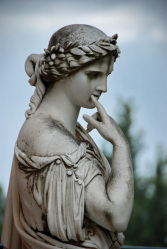 For centuries writers made a habit of dedicating to the muses for luck. As I’ve mentioned before, Calliope is the writer’s muse and my blog and all the writing on it is dedicated to her. Here are a few examples of writers paying homage:
For centuries writers made a habit of dedicating to the muses for luck. As I’ve mentioned before, Calliope is the writer’s muse and my blog and all the writing on it is dedicated to her. Here are a few examples of writers paying homage:
William Shakespeare, Henry V:
O for a Muse of fire, that would ascend
The brightest heaven of invention,
A kingdom for a stage, princes to act
And monarchs to behold the swelling scene!
Charles Baudelaire, The Venal Muse:
O muse of my heart, lover of palaces,
Will you bring, when January lets loose its sleet
And its black evenings without solace,
An ember to warm my violet feet?
What will revive your bruised shoulders,
The nocturnal rays that pierce the shutters?
When you cannot feel your palace, just your empty billfold,
How will you harvest the gold of azure vaults and gutters?
You should, to earn your bread today
Like a choir boy with a censer to wave,
Sings hymns with feeling but without belief.
Or, a starving rip-off artist, selling your charm
And your laughter shades the tears so no one sees the harm
In bringing to bloom an ordinary rat, a vulgar thief.
John Milton, Paradise Lost:
Of Man’s first disobedience, and the fruit
Of that forbidden tree whose mortal taste
Brought death into the World, and all our woe,
With loss of Eden, till one greater Man
Restore us, and regain the blissful Seat,
Sing, Heavenly Muse…
Homer’s Odyssey:
Sing to me of the man, Muse, the man of twists and turns
driven time and again off course, once he had plundered
the hallowed heights of Troy.
Dante’s Inferno:
O Muses, O high genius, aid me now!
O memory that engraved the things I saw,
Here shall your worth be manifest to all!
Emily Dickinson, Awake ye muses nine:
Awake ye muses nine, sing me a strain divine,
Unwind the solemn twine, and tie my Valentine!
The Aeneid by Virgil:
O Muse! the causes and the crimes relate;
What goddess was provok’d, and whence her hate;
For what offense the Queen of Heav’n began
To persecute so brave, so just a man…
Geoffrey Chaucer, Troilus:
O lady myn, that called art Cleo,
Thow be my speed fro this forth, and my Muse,
To ryme wel this book til I haue do…
Thomas Moore, While History’s Muse:
While History’s Muse the memorial was keeping
Of all that the dark hand of Destiny weaves,
Beside her the Genius of Erin stood weeping,
For hers was the story that blotted the leaves.
But oh! how the tear in her eyelids grew bright,
When, after whole pages of sorrow and shame,
She saw History write,
With a pencil of light
That illumed the whole volume, her Wellington’s name.
Mary Darby Robinson, Ode to the Muse:
While softly o’er the pearl-deck’d plain,
Cold Dian leads the sylvan train;
In mazy dance and sportive glee,
SWEET MUSE, I’ll fondly turn to thee;
And thou shalt deck my couch with flow’rs,
And wing with joy my silent hours.
William Blake, To the Muses:
Whether on crystal rocks ye rove,
Beneath the bosom of the sea
Wand’ring in many a coral grove,
Fair Nine, forsaking Poetry!
How have you left the ancient love
That bards of old enjoy’d in you!
The languid strings do scarcely move!
The sound is forc’d, the notes are few!
Phillis Wheatley:
There shall thy tongue in heav’nly murmurs flows,
And there my muse with heav’nly transport glow:
No more to tell of Damon’s tender sighs,
Or rising radiance of Aurora’s eyes,
For nobler themes demand a nobler strain,
And purer language on th’ ethereal plain.
Cease, gentle muse! the solemn gloom of night
Now seals the fair creation from my sight.
Catullus:
And so, have them for yourself, whatever kind of book it is,
and whatever sort, oh patron Muse
let it last for more than one generation, eternally.
~❋~
 Phraseology I often wonder where certain words and sayings come from. For the next few weeks this word collector will examine familiar phrases to get at their heart. I think you’ll be surprised.
Phraseology I often wonder where certain words and sayings come from. For the next few weeks this word collector will examine familiar phrases to get at their heart. I think you’ll be surprised.
The phrase for today is ~Dressed to the nines
This phrase is used to describe someone dressed smartly or flamboyantly. Some people believe this is about tailors once using nine yards of material to make a shirt, as in, the more material you had the more wealth you had. As someone who put years into researching historical clothing, I’d have to say I don’t believe this to be true. There’s just no evidence to support it.
In The Progressive Dictionary of the English Language of 1835, the author takes a stab at it. He says perhaps the phrase was originally dressed to thine eyes. That’s better than the first, but still no written proof of such a transition. However, it does show up in print early on as to the nine. That has a dedication feel to it doesn’t it? In medieval Europe The Nine Worthies appear in print. These distinguished fellows were derived from Pagan and Jewish history as well as tales from the Bible and consisted of Judas Maccabaeus, Joshua, David, Hector, Alexander, Julius Caesar, King Arthur, Godfrey de Bouillon, and Charlemagne. This makes more sense to me than the other possible origins. But…one of the earliest references of To the Nine from the early 1600s says this:
The learned tribe whose works the World do bless,
Finish those works in some recess;
Both the Philosopher and Divine,
And Poets most who still make their address
In private to the Nine.
Philosophers and poets? That says Muse to me. Hmm…Does this mean if I dress to the nines this week, Calliope will return?
:)
Other Wednesday Happenings
Books Hooks
http://theancillarymuse.blogspot.com/
Paranormal Love Wednesday *NEW for me*
http://calliopesotherwritingtablet.blogspot.com/
Hump Day Blurb Share
(Open promo opportunity for authors. Readers find great reads!)
http://exquisitequills.blogspot.com/
~❋~❋~❋~
 Today’s guest is Author Maggie Le Page.
Today’s guest is Author Maggie Le Page.
http://romancebooks4us.blogspot.com/
Romance Books ‘4’ Us ~ Our February contest is on.
Two – $50 GIFT CARDS & MORE.
~❋~❋~❋~❋~❋~❋~❋~❋~❋~❋~❋~
If you enjoy my daily musings, subscribe to get them sent to your inbox, or if your inbox is as packed as mine is, check out the Networked Blogs tab on the right and get all the blogs you follow in one daily notice. A year full of curious and compelling posts awaits!
 Sample my scorching love stories for free!
Sample my scorching love stories for free!
~Coming Soon~


February 10, 2015
Trippin’ with Sybil
Even as a child I could entertain myself. My imagination was always active — I’d draw, sculpt, carve, color, and cut paper for hours. Because that innate desire to create appeared early on in my life, my mother always wished I’d be an artist of some sort. To that end, she supplied me with all sorts of tools and materials and loaded me up with books on famous paintings. On top of that, the Chicago Art Institute was a car ride away. As mentioned yesterday, though I came very close, I never continued on in the tangible arts. I went in another creative direction entirely.
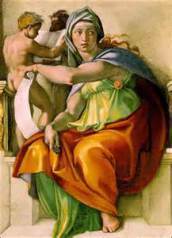 Anyway…
Anyway…
In my stack of art books, I had one on Michelangelo and the Sistine Chapel. I spent hours poring over the details. The artist was a master at painting perspective and tromp l’oeil — quite impressive considering he painted much of the enormous ceiling on his back. Of all the fantastic images and vignettes there, the women outside the biblical reference drew my attention. These are the Sibyllae also known as Sybil (Sibyl). There are five depicted on the Sistine Chapel ceiling though some sources say the ancients ascribed to at least a dozen prophetess’. The women Michelangelo painted are the Libyan Sibyl, Delphic Sybil, the Cumaean Sibyl, the Persian Sibyl, and the Erythraean Sibyl. Of these, one in particular caught my eye. It was the Delphic Sybil; better known as the Oracle At Delphi.
Just prior to the Sybil coming on the scene and her temple being built, 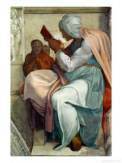 a goatherd tending his flock on the slope of Mount Parnassus noticed his goats bleated strangely when grazing near a certain fissure in the mountainside. Drawing near, he was seized by what he referred to as divine presence. Unknown at the time, the mechanics of this presence involved plate tectonics, those mobile rocky plates forming the earth’s surface. The two that came together there, the Eurasian Continental Plate and the Aegean Plate, created the fissure. It was here through the porous rock along the crevasse that methane and ethane, two toxic hydrocarbon gasses, were released into the air.
a goatherd tending his flock on the slope of Mount Parnassus noticed his goats bleated strangely when grazing near a certain fissure in the mountainside. Drawing near, he was seized by what he referred to as divine presence. Unknown at the time, the mechanics of this presence involved plate tectonics, those mobile rocky plates forming the earth’s surface. The two that came together there, the Eurasian Continental Plate and the Aegean Plate, created the fissure. It was here through the porous rock along the crevasse that methane and ethane, two toxic hydrocarbon gasses, were released into the air.
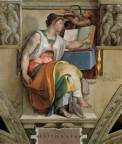 This mountainside soon became one of the most important religious sites of the ancient world. A stone temple dedicated to the god Apollo was erected in a natural amphitheater. They had a feeling the airs of the temple had special properties so a small alcove was built to catch the fumes from the fissure and the CO2 from the rich waters of a sacred spring deliberately channeled through the temple. Inside the temple walls sat the Pythia — specially trained women who dedicated themselves to Apollo. They became the Delphic Oracles.
This mountainside soon became one of the most important religious sites of the ancient world. A stone temple dedicated to the god Apollo was erected in a natural amphitheater. They had a feeling the airs of the temple had special properties so a small alcove was built to catch the fumes from the fissure and the CO2 from the rich waters of a sacred spring deliberately channeled through the temple. Inside the temple walls sat the Pythia — specially trained women who dedicated themselves to Apollo. They became the Delphic Oracles.
The Prophetess~ After preparing herself through fasting and cleansing, the Oracle sat on her special tripod stool and breathed it all in. Wracked with spasms, she fell into an exalted state of mind. From this toxic trance, she responded to questions and gave advice with prophetic wisdom directly inspired by Apollo himself. It was said at times she was spot on in her prophecy, but occasionally she babbled and didn’t make sense. At times her answers were clear, but were beyond the understanding of the questioner.
After preparing herself through fasting and cleansing, the Oracle sat on her special tripod stool and breathed it all in. Wracked with spasms, she fell into an exalted state of mind. From this toxic trance, she responded to questions and gave advice with prophetic wisdom directly inspired by Apollo himself. It was said at times she was spot on in her prophecy, but occasionally she babbled and didn’t make sense. At times her answers were clear, but were beyond the understanding of the questioner.
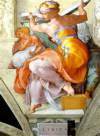 It’s curious to note she only divined on special days. To do otherwise would prove deadly from the build-up of toxins in the brain. On at least one occasion the Pythia was forced from her divine schedule, and sure enough, she went into seizures and died a few days later. I’ve wondered about this for more than half of my life. There was significance to the schedule, but how was it one day was safer than the next? The oracles spoke at Delphi for a thousand years.
It’s curious to note she only divined on special days. To do otherwise would prove deadly from the build-up of toxins in the brain. On at least one occasion the Pythia was forced from her divine schedule, and sure enough, she went into seizures and died a few days later. I’ve wondered about this for more than half of my life. There was significance to the schedule, but how was it one day was safer than the next? The oracles spoke at Delphi for a thousand years.
More~
This wiki has a list of Sibyllae. Better still, it also has terrific Notes with links to original sources.
❋❋❋
 Phraseology I often wonder where certain words and sayings come from. For the next few weeks this word collector will examine familiar phrases to get at their heart. I think you’ll be surprised.
Phraseology I often wonder where certain words and sayings come from. For the next few weeks this word collector will examine familiar phrases to get at their heart. I think you’ll be surprised.
The phrase for today is ~Ask me no questions and I’ll tell you no lies.
At a glance, this one is pretty self-explanatory on how it’s used today. It means I won’t be able to tell you the truth if you ask me that question, so don’t ask.
It’s attributed to a 1700s Irish playwright named Oliver Goldsmith. Oliver was known for catchy one-liners. Some form the basis of versions we use today — Forrest Gump’s stupid is as stupid does likely came from Oliver Goldsmith’s handsome is as handsome does.
~❋~❋~❋~
 Today is Author R. Ann Siracusa’s blog day.
Today is Author R. Ann Siracusa’s blog day.
http://romancebooks4us.blogspot.com/
Romance Books ‘4’ Us ~ Our February contest is on.
Two – $50 GIFT CARDS & MORE.
~❋~❋~❋~❋~❋~❋~❋~❋~❋~❋~❋~
If you enjoy my daily musings, subscribe to get them sent to your inbox, or if your inbox is as packed as mine is, check out the Networked Blogs tab on the right and get all the blogs you follow in one daily notice. A year full of curious and compelling posts awaits!
 Sample my scorching love stories for free!
Sample my scorching love stories for free!
~Coming Soon~


February 9, 2015
Cupid, draw back your bow…
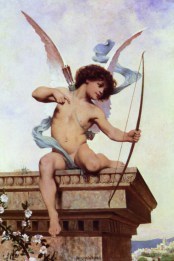 When I met the love of my life, it was literally love at first sight for us both. We had different life plans at the time. I wasn’t looking, he wasn’t looking. He had just returned from hitchhiking cross-country (back when everyone was doing it and no one considered it unsafe), and was settling into life as a journalism student. I was one semester away from leaving Chicago for an art scholarship out west.
When I met the love of my life, it was literally love at first sight for us both. We had different life plans at the time. I wasn’t looking, he wasn’t looking. He had just returned from hitchhiking cross-country (back when everyone was doing it and no one considered it unsafe), and was settling into life as a journalism student. I was one semester away from leaving Chicago for an art scholarship out west.
But Cupid had other plans. His arrow struck us both and it was totally unexpected. It was life-changing. It was fate. True love is like that. Because of what we experienced, I always write that love into my romances. Readers often comment on the realistic love they read between my characters. I write that emotion from life. It’s what I know.
:D
With Valentine’s Day around the corner, today I’m giving a nod to that rascally cherub who blindsided us and set our feet on a completely different path.
Depending on which mythology you ascribe to, this pudgy little deity has different parents. To the Romans, Cupid is the immortal son of Venus (Aphrodite) and Mars (Ares) – an allegorical blending of love and war. His name comes from the Latin word cupido meaning desire.
To the Orphic and Greek philosophers, he was Eros the son of Nyx the Night and Boreas the North Wind – the first complete manifestation of Divinity. In other depictions, Cupid is considered a primordial god or proto-god e.g. an old one who came before Zeus and even before Zeus’ grandparents Gaia and Uranus. No matter what sidebars exist for this immortal, from the very beginning, even before the fabric of the universe was woven, Cupid personified love and passion. Fertility cults, and other things, rose in his honor.
He wasn’t always depicted as the cute pudgy baby with wings either. There’s a story that says Venus complained that her son grew no bigger than a child. Venus was told by Themis, a prophetic Titan goddess, that if Cupid had a brother he would soon start to grow. Sure enough, Cupid immediately gained size and strength after his brother Anteros was born. Some tales have him older or with multiple heads, four eyes, and various animal attributes.
In other mythic versions, Cupid is blindfolded, and only the truest hearts will draw his blindly shot arrows. Those arrows have a little known detail that always gets overlooked as Valentine’s Day approaches. He carries two arrows in his quiver – one of love and another of hate. Think about that. Those strong emotions really are two sides to the same coin.
Those two arrows make him a symbol of the uniting powers of emotion. Cupid is the bringer of order and harmony to the universe. Because of the love/hate duality involved, some mythic tales make him a fundamental contributor in the formation of the world. Another story has him fall in love with a mortal woman named Psyche. I find this interesting because Cupid is synonymous with love and Psyche is the personification of the soul. One could infer the lesson here is love is essential to one’s soul. Who knew Cupid was such a multifaceted little amorino?
I can see Cupid in my mind’s eye… his arrow notched on his bow. He doesn’t care if the timing is right or wrong for you. He doesn’t care if you’re looking for love or not. Tucked behind a tree or rock, he’s poised to let his charmed arrow fly at just the right moment. When it hits, it’s totally unanticipated. It’s fate. Sometimes love is like that. Sometimes it waits in unexpected places.
More~
Thomas Bulfinch was my early introduction to the myths and I just loved it. Read about Cupid and Psyche in his The Age of Fable or Stories of Gods and Heroes.
Download several of Thomas Bulfinch’s fantastic works for free here:
http://www.gutenberg.org/ebooks/search/?query=Thomas+Bulfinch
❋❋❋
 Phraseology I often wonder where certain words and sayings come from. For the next few weeks this word collector will examine familiar phrases to get at their heart. I think you’ll be surprised.
Phraseology I often wonder where certain words and sayings come from. For the next few weeks this word collector will examine familiar phrases to get at their heart. I think you’ll be surprised.
The phrase for today is ~Love is blind
We understand this phrase as meaning when we’re in love we never see the other person’s flaws that are so apparent to everyone else. Curiously, there is scientific research supporting the love is blind concept. Feelings of love suppress those areas of the brain controlling critical thought. Fun stuff. I was certainly knocked for a loop when I fell in love. Neither of us could concentrate.
The first time this expression shows up in print is around 1400 in Jeffrey Chaucer’s Merchant’s Tale where he alludes to love being a nighttime thing and not in the bright light of day. Again this might have to do with seeing flaws in full sunlight. Shakespeare takes this and makes it the recognizable form we know today. In his The Merchant Of Venice the bard wrote this bit where Jessica is disguised as a boy to escape her father:
I am glad ’tis night, you do not look on me,
For I am much ashamed of my exchange:
But love is blind and lovers cannot see
The pretty follies that themselves commit;
For if they could, Cupid himself would blush
To see me thus transformed to a boy.
~❋~❋~❋~
 Today is Author Melissa Keir’s blog day.
Today is Author Melissa Keir’s blog day.
http://romancebooks4us.blogspot.com/
Romance Books ‘4’ Us ~ Our February contest is on.
Two – $50 GIFT CARDS & MORE.
~❋~❋~❋~❋~❋~❋~❋~❋~❋~❋~❋~
If you enjoy my daily musings, subscribe to get them sent to your inbox, or if your inbox is as packed as mine is, check out the Networked Blogs tab on the right and get all the blogs you follow in one daily notice. A year full of curious and compelling posts awaits!
 Sample my scorching love stories for free!
Sample my scorching love stories for free!
~Coming Soon~








